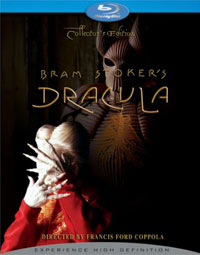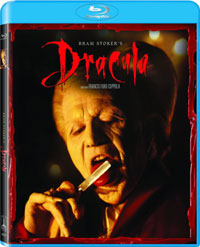


DVDSleuth.com is your source for daily DVD news and reviews.


Bram Stoker's Dracula (1992)
Sony Pictures Home Entertainment
Blu-ray Disc Released: 10/2/2007
All Ratings out of ![]()
![]()
![]()
![]()
![]()
Movie: ![]()
![]()
Video: ![]()
![]()
![]()
Audio: ![]()
![]()
![]() 1/2
1/2
Extras: ![]()
![]()
![]() 1/2
1/2
Review by Mike Long, Posted on 9/26/2007; Updated on 10/6/2015
OK, here's the scenario: Some close to you -- a friend, a significant other, a parent -- decides to cook you a fancy meal. You watch as they prepare and cook the food. Once you sit down to eat, you find that the dish is only so-so. Do you give the person the benefit of the doubt because you know how much trouble they went through to make it? This is the question I ask myself about movies sometimes. Do I give a movie a break when I know that literally hundreds of people toiled to make it? A good example of this is Francis Ford Coppola's exercise in excess Bram Stoker's Dracula.
The conceit of Bram Stoker's Dracula is that it's the first film to truly follow Stoker's classic novel. The story opens in 15th century Transylvania. Lord Dracul (Gary Oldman) has led his people into battle against the Turks. While he is away, his wife, Elisabeta (Winona Ryder) is tricked into thinking that he is dead and she kills herself. Upon returning from war and finding his love dead, Dracul renounces God.
The story then jumps ahead to London, 1897. Young attorney Jonathan Harker (Keanu Reeves) has been chosen to travel to Transylvania to assist a Count Dracula (Gary Oldman) who is buying property in London. (The first attorney who was sent to assist Dracula, Renfield (Tom Waits), returned to London quite mad.) Harker knows that this is a great opportunity, but he hates to leave his fiancee, Mina (Winona Ryder). Harker makes the harrowing trip to Dracula's castle, and once there, finds Dracula to be a very strange, ancient man. (We quickly realize that Dracula is now a vampire.) When Dracula sees a portrait of Mina (who looks just like his lost Elisabeta), he insists that Harker stay for a month. Meanwhile, Mina is busy with her best friend Lucy (Sadie Frost), who is fielding suitors. Both women begin to feel strange sensations as Dracula reaches out with his mind to them. Soon, Dracula is on his way to London (in the hold of a ship), and once he reaches the city, Lucy falls completely under her spell. At a loss as to how to help Lucy, her physician, Dr. Jack Seward (Richard E. Grant), call in an expert, Professor Abraham Van Helsing (Anthony Hopkins). At this same time, Mina meets a dark stranger -- Dracula, making himself look much younger -- who begins to court her. She finds the man strangely irresistible. Back in Transylvania, Harker is attempting to escape from Dracula's castle. Can any of them stop the Count from taking Lucy and Mina?
I always try to give credit where credit is due and Francis Ford Coppola must be praised for trying something different with Bram Stoker's Dracula. First of all, the film was something different for Coppola himself. The man had worked in many genres in his distinguished career, but he hadn't made a horror movie since 1963's Dementia 13 (unless you count Apocalypse Now as a horror movie). Secondly, as noted above, this was to be the first true adaptation of Bram Stoker's novel, Dracula. Other films had taken bits and pieces from the novel, but Coppola and screenwriter James V. Hart wanted to be as faithful to the book as possible.
But, what really makes Bram Stoker's Dracula unique is the bombastic and operatic way in which the story is told. In short, this movie is all about style. It's hard to believe that the film only cost a reported $40 million, as each costume, set, and scary makeup is more lavish than the last. Coppola incorporates many filmmaking techniques to tell the story and his color palette is quite wide here. The costumes are flamboyant to say the least, especially those of Dracula. The sets, from Lucy's garden to Dracula's castle, are massive. Dracula is able to take on many forms and his wolf-bat makeup is startling. Coppola and his son Roman used many old-fashioned trick photography tactics to fill the film with bizarre and misleading visuals. (The most famous of which is the scenes in which Dracula's shadow moves on its own.)
But, it's this over-the-top nature which ultimately dooms the film. Despite the fact that Bram Stoker's Dracula uses many old photography effects, at the outset, the movie feels very unique. The effects, combined with the lavish costumes (Dracula's armor in the opening scene doesn't look very practical, but it's undeniably cool) are instantly intriguing and it's very easy for the audience to be entranced by the film. But, it doesn't take long for the viewer to realize that this pomp and circumstance is all that the movie has to offer. The heavy-handed acting would be grating in most any film, but it truly fails to inspire here, especially in the hands of Ryder and Reeves, who come across as being out of their elements. The constant parade of visual effects loses its charm after a while and one feels that Coppola is using them to distract us from the story. The script is all over the map and many things aren't made clear. Who is Van Helsing? Is Mina really attracted to Dracula, or is it part of his powers? And the ultimate question, as stated by Sinbad, "Why do they go to Dracula's castle at 5:45?" The movie is interesting at first, but the middle drags at an excruciating pace. Bram Stoker's Dracula isn't bashful about nudity or violence, but they feel tacked on to this odd period piece. The finale is full of action, but by that point, most viewers won't care.
Having watched the documentaries on this disc, I know how much work Coppola and his crew put into Bram Stoker's Dracula and it's easy to see how passionate and uncompromising Coppola was about the film. The man should be applauded for having the guts to make such a uniquely visual film. Unfortunately, he forgot to make it entertaining and the end result is a beautiful mess.
Bram Stoker's Dracula runs red on Blu-ray Disc courtesy of Sony Pictures Home Entertainment. The film has been letterboxed at 1.85:1 and the tansfer is full 1080p, 16 x 9. Do you remember when CDs first came out and their clarity revealed problems with older recordings? We get the same effect here. Some shots here look sharp and clear. But some, like Elisabeta's suicide are incredibly grainy. The colors, which are integral to the movie, do look good here. The dominant color is, of course, red, but the other hues are nicely presented and the image is well-balanced, with the dark scenes never being overly dark. But, even the clear scenes look somewhat flat. I've noticed that some Blu-ray transfers offer the kind of depth that one gets when watching a film in a theater. We don't get that here. The DVD fares somewhat better in the audio department. The disc carries an uncompressed PCM 5.1 audio track. This track provides clear dialogue and sound effects (although I still have no idea what Gary Oldman was saying). The film's sound design comes through well here, as we get a nice demonstration of stereo and surround sound effects. The film takes every opportunity to offer up nice effects, from the attack scenes, to the sounds of the ship, to Harker's carriage ride. These effects are somewhat subtle though, and they're never overwhelming. The subwoofer effects are subtle as well, but they do add to the action sequences.
This release contains several extras. Francis Ford Coppola provides an AUDIO COMMENTARY for the film, which is also available in subtitle form. Much like the film, Coppola is all over the place in this talk, trying to describe as much of the on-screen action as possible. He discusses the story, the sets, the effects, and everything in between. In between his rambling, we do learn about the film. But, we learn more in "The Blood is the Life: The Making of Dracula". This 28-minute documentary gives us glimpses of production meetings in which Coppola meticulously plans the film. We get comments from Coppola, Hart, and the cast, videos of rehearsals, and a look at the makeup FX. There is a discussion of using the source novel to distance the film from other vampire movies. "The Costumes are the Sets: The Design of Eiko Ishioka" (14 minutes) profiles the designer and shows concept drawings of her work. Roman Coppola hosts "In-Camera: The Naive Visual Effects of Dracula" (19 minutes), where he and his father cite specific scenes to explain how the effects were done. The creation of the film's storyboards is uncovered in "Method and Madness -- Visualizing Dracula" (12 minutes). The disc contains 12 DELETED SCENES which run about 28 minutes. These are actually extended scenes with some new footage added to scenes from the final cut. Finally, we have the TRAILER and TEASER TRAILER.
UPDATE:
On October 6, 2015, Sony Pictures Home Entertainment released a new special edition Blu-ray Disc of Bram Stoker's Dracula, which touted a new 4K transfer. Watching this, it's clear that some of the defects found in the previous release were native to the film itself, as they are reproduced here. The film has been letterboxed at 1:85:1 and the Disc contains an AVC 1080p HD transfer which runs at an average of 22 Mbps. As before, some shots are noticeably grainy, while some are clear. Overall, there are no defects from the source materials. The colors look great, most notably the reds. However, the image is somewhat dark in places, resulting in a dull look. The depth vacillates as well, although the level of detail remains consistently good. The Disc carries a Dolby TrueHD 7.1 audio track which runs at 48 kHz and an average of 5.0 Mpbs. The track provides clear dialogue and sound effects. This is a nicely detailed track and it has a very layered feel to it, as we can pick out minute sounds. The stereo effects are very good, showing nice separation. The subwoofer is subtle but effective and the surround sound effects add depth to the action sequences.
This new release does include some original special features. We begin with an AUDIO COMMENTARY from Director Francis Ford Coppola, Visual Effects Director Roman Coppola and Makeup Supervisor Greg Cannom. Coppola also provides a new "Introduction" (4 minutes), in which he waxes about the history of Dracula films. "Reflections in Blood: Francis Ford Coppola and Bram Stoker's Dracula" (29 minutes) is a new documentary in which film critic F.X. Feeney interviews Coppola. They discuss many facets of the film, focusing on the story and then moving on to the film's production, with a heavy emphasis placed on the effects and the look of the movie. Roman Coppola jumps into this conversation in "Practical Magicians: A Collaboration Between Father and Son" (20 minutes), where the two Coppolas talk about the live-action effects used in the film and the challenges which this posed.
Review Copyright 2007/2015 by Mike Long